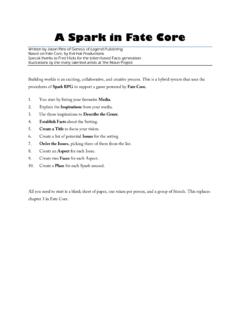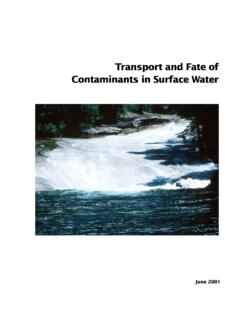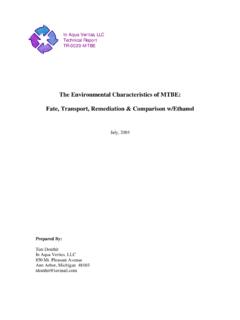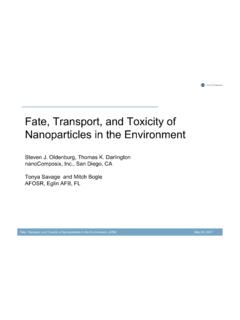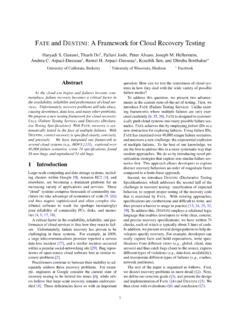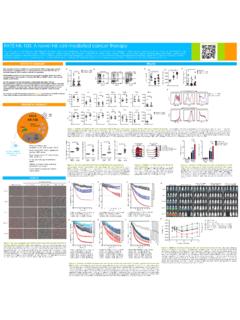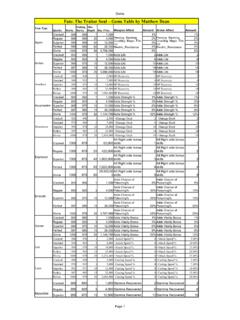Transcription of Chapter 16 - known-fate models - phidot.org
1 CHAPTER16 known -fate modelsIn previous chapters, we ve spent a considerable amount of time modeling situations where theprobability of encountering an individual is less than 1. However, there is at least one situation wherewe do not have to model detection probability known fate data, so-called because weknowthe fateof each marked animal with certainty. In other words, encounter probability is (which must betrue if we know the fate of a marked individual with certainty). This situation typically arises whenindividuals are radio-marked, although certain kinds of data from sessile organisms ( , plants) canalso be analyzed with the known fate data type.
2 In such cases, known fate data are important becausethey provide a theory for estimation of survival probability and other focus ofknown fate models is the estimation ofsurvivalprobabilityS,the probabilityofsurvivingan interval between sampling occasions. These are models where it can be assumed that the samplingprobabilities are 1. That is, the status (dead or alive) of all tagged animals is known at each samplingoccasion. For this reason, precision is typically quite high, as precise as the binomial distribution allows,even in cases where sample size is often fairly small.
3 The only disadvantages might be the cost of radiosand possible effects of the radio on the animal or its behavior. The model is a product of simple binomiallikelihoods. Data on egg mortality in nests and studies of sessile organisms, such as mollusks, have alsobeen modeled as known fate fact, the known fate data type is exactly the same as logistic regression in any statistical main advantage of usingMARKfor known fate analysis is the convenience of model selection, andthe capabilities to model average survival estimates easily, and compute random effects The Kaplan-Meier MethodThe traditional starting point for the analysis of known fate data is the Kaplan-Meier (1958)
4 Estimator we ll discuss it briefly here, before introducing a more flexible approach that will serve as the basis forthe rest of this Kaplan-Meier (hereafter, K-M)estimator is based on observed data at a series of occasions, whereanimals are marked and released only at occasion 1. The K-M estimator of the survival function is (C=C 8=1(=8 38=8),where=8is the number of animals alive and at risk of death at occasion8(given that their fate is knownat the end of the interval),38is the number known dead at occasioni, and the product is over8up to Cooch & White (2021) The Kaplan-Meier Method16 -2theCth occasion (this estimator is often referred to as the product-limit estimator).)
5 Critical here is that=8is the number known alive at the start of occasion8and whose fate (either alive or dead) is knownat the end of the interval. Thus, the term in parentheses is just the estimated survival for that=8does not include individuals censored during the is rare that a survival studywill observe the occasion of death of every individual in thestudy. Animals are lost ( , censored) dueto radio failure or other reasons. The treatment of such censored animals is often important, but oftensomewhat subjective. These K-M estimates produce a survival function (see White and Garrott 1990);the cumulative survival up to timeC.
6 This is a step function and is useful in comparing, for example,the survival functions for males vs. females. If there are noanimals that are censored, then the survivalfunction (empirical survival function or ESF) is merely, (C=(number alive longer thant=)forC is the same as the intuitive estimator where no censoring is occurring: (C==C+1/=C; for example, (2==3/=2. The K-M method is an estimate of this survival function in the presence of for the variance of these estimates can be foundin White & Garrott (1990).A simple example of this method can be illustrated using the data from Conroyet al.)))
7 (1989) on 48radio-tagged black ducks. The data aresurvived to occasionweek1 2 3 4 5 6 7 8number alive at start48 47 45 39 34 28 25 24number dying1 2 2 5 4 3 1 0number alive at end47 45 39 34 28 25 24 24number censored0 0 4 0 2 0 0 0 Here,the number alive at the start of an interval areto knownbe alive at the start of sampling occasionj. This is equivalent to being alive at the start of intervalj. For example, 47 animals are known to bealive at the beginning of occasion 2.
8 Forty-five are alive at the start of interval 3, but 4 are censored fromthese 45 because their fate is unknown at the end of the interval, so that=3=41. A further example isthat 34 ducks survived to the start of occasion , the MLEs are (1=(47/48)= (2=(45/47)= (3=(39/41)= (note: only 41 because 4 were censored) (4=(34/39)= (5=(28/32)= (note: only 32 because 2 were censored) (6=(25/28)= (7=(24/25)= (8=(24/24)= one estimates 8 parameters call this models (t). One could seek a more parsimonious modelin several ways. For example, perhaps all the parameters were nearly constant; thus a model with aChapter 16.))))))))
9 known -fate The binomial model16 -3single survival probability might suffice ( ,S(.)) Or, one might consider fitting some smooth functionacross the occasions and, thus, have perhaps only one intercept and one slope parameter (instead of 8parameters). Still other possibilities exist for both parsimonious modeling and probable heterogeneityof survival probability across animals. These extensions are not possible with the K-M method, and K-L-based ( , AIC) model selection is not possible. To do this, we need an approach based on maximumlikelihood estimation as it turns out, the simple binomialmodel will do just that for known fate The binomial modelIn the K-M approach, we estimated the survival probability by (C=C 8=1(=8 38=8),where38is the number dying over the8th interval, and=8is the number alive ( at risk ) at the start ofthe interval and whose fate is also known at the end of the interval ( , not censored).)
10 Here, we usethe equivalence (under some conditions) of the K-M estimator, and a binomial estimator, to recast theproblem in a familiar likelihood case in which all animals are released at some initial timeC=0,and thereis no we expand the product term from the preceding equation, over the interval[0, C], (C=(=0 30=0) (=1 31=1)..(=C 3C=C).We notice that in the absence of censoring (which we assume for the moment), the number of animalsat risk at the start of an interval is always the previous number at risk, minus the number that died theprevious , we can re-write the expanded expression as (C=(=0 30=0) (=1 31=1).))
